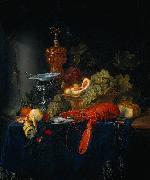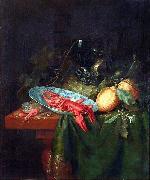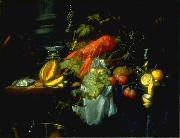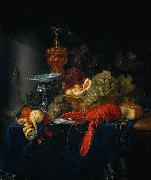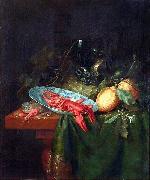|
||||||||||
|
|
||||||||||
|
Still Life with a Golden Goblet Pintura Identificación:: 74326 Vea nuestra galería en Suecia |
Still Life with a Golden Goblet c. 1635 - 60 Oil on canvas 100 x 85 cm cjr c._1635_-_60 _ Oil_on_canvas _ 100_x_85_cm _ cjr |
|||||||||
|
|
||||||||||
|
Stilleben mit Romer, Krebsen und Zitronen Pintura Identificación:: 74421 Vea nuestra galería en Suecia |
Stilleben mit Romer, Krebsen und Zitronen Oil on canvas 58,2 x 48,1 cm cjr Oil_on_canvas _ 58,2_x_48,1_cm _ cjr |
|||||||||
|
|
||||||||||
|
Still Life with Lobster Pintura Identificación:: 74536 Vea nuestra galería en Suecia |
Still Life with Lobster c. 1650 Oil on canvas 89.5 x 116.8 cm cjr c._1650 _ Oil_on_canvas _ 89.5_x_116.8_cm _ cjr |
|||||||||
|
|
||||||||||
|
Still Life with a Golden Goblet Pintura Identificación:: 75761 Vea nuestra galería en Suecia |
Still Life with a Golden Goblet Date c. 1635 - 60 Medium Oil on canvas Dimensions 100 x 85 cm cyf Date_c._1635_-_60 _ Medium_Oil_on_canvas _ Dimensions_100_x_85_cm _ cyf |
|||||||||
|
|
||||||||||
|
Krebsen und Zitronen Pintura Identificación:: 75771 Vea nuestra galería en Suecia |
Krebsen und Zitronen Medium Oil on canvas Dimensions 58,2 x 48,1 cm cyf Medium_Oil_on_canvas _ Dimensions_58,2_x_48,1_cm _ cyf |
|||||||||
|
|
||||||||||
| Artista Previo Próximo Artista | ||||||||||
|
|
||||||||||
| Pieter de Ring | ||||||||||
| (1615/1620 - 22 September 1660, Leiden) was a Dutch Golden Age painter of still lifes. became famous for his opulent, flashy still lifes or banquet pieces with fruit, a lobster, a goblet, shrimps, oysters, a rug and Chinese porcelain. His signature is often a painted ring or with the Latinised form of his name, P.Ab.Annulo. De Ring was born either in Leiden, or in Ypres in Flanders, but there is no trace of his birth in the Leiden archives, and the Ypres Archives were destroyed in August 1914. Pieter de Ring started as a mason and painted still lifes in the evening. When the hall was filled with paintings he became a pupil of Jan Davidsz. de Heem, until 1635 living in Leiden. His father Daniel died in 1648; in 1657 his mother lived in Amsterdam. De Ring himself lived in a house at Hogewoerd. There are no records in the Leiden Archive on his marriage or children. He appears not to have bought a house there nor wrote a will. What is known is that he became one of the founders a member and of the Guild of St. Luke in 1648, De Ring was buried in the Pieterskerk, Leiden on 22 September 1660 and taken to church from a house in the Nonnensteeg. If he had his studio there he probably had a view on the Leiden Academy building. If he lived on the east side of the alley he had a beautiful view on the Hortus Botanicus of Leiden, the work of Clusius. | ||||||||||
|
|
||||||||||
IntoFineArt Co,.Ltd.








